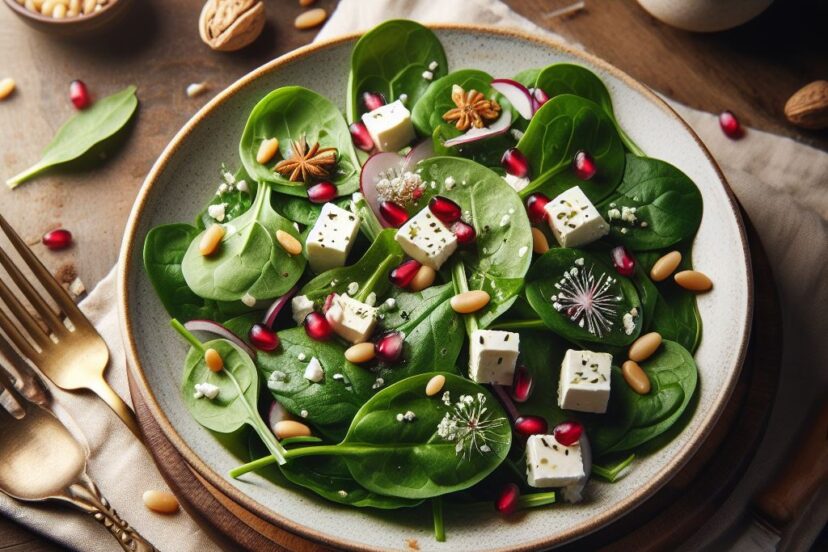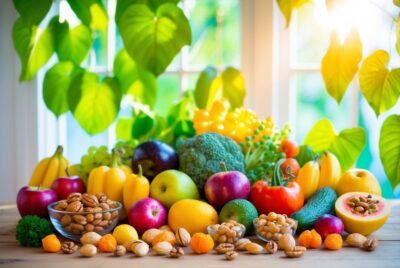Baby Spinach Nutrition: The Powerhouse of Vitamins and Minerals
*We may earn a commission for purchases made using our links. Please see our disclosure to learn more.
Baby Spinach Nutrition: A Comprehensive Guide to Benefits and Facts
As a nutritious powerhouse, baby spinach is an excellent addition to a healthy diet. So let’s jump into Baby Spinach Nutrition! Leveraging its low calorie content and high fiber levels, I can easily integrate it into meals to enhance my overall nutrient intake. The tender leaves of baby spinach are not just versatile for culinary use, they also offer a spectrum of vitamins and minerals, including vitamin A, C, and K, iron, and calcium. Including baby spinach in my regular diet supports weight management and promotes a feeling of fullness, which is beneficial for those looking to maintain or lose weight.
The benefits of consuming baby spinach extend beyond its vitamin and mineral content. It’s notably rich in antioxidants, compounds which play a critical role in reducing oxidative stress and inflammation in my body. These antioxidants, such as lutein and zeaxanthin, are also known to be beneficial for eye health. By incorporating baby spinach into my diet, I’m taking a proactive step towards preventing chronic diseases and supporting the overall health of various bodily systems, including my cardiovascular system.
Understanding the right way to prepare and store baby spinach ensures that I maximize its nutritional benefits. Cooking methods can impact the nutrient profile, so it’s important to be mindful of how I cook my spinach. Eating it raw in salads, or gently steaming it to retain most of its nutrients, allows me to make the most of this green vegetable. Whether I’m looking for a nutritious ingredient for my smoothies, salads, or cooked dishes, baby spinach is a versatile and healthful choice that fits seamlessly into my daily meals.
Nutritional Profile of Baby Spinach

Baby spinach is a nutrient-dense leafy green packed with essential vitamins, minerals, and macronutrients. It’s low in calories but high in vital nutrients, making it an excellent addition to a healthy diet.
Vitamin and Mineral Content
In my exploration of baby spinach’s nutritional content, I find it particularly rich in vitamin A, vitamin K, and vitamin C, all of which are crucial for maintaining good health.
- Vitamin A: Important for vision, the immune system, and reproduction.
- Vitamin K: Essential for blood clotting and bone health.
- Vitamin C: Necessary for the growth, development, and repair of all body tissues.
Beyond these vitamins, baby spinach also provides a good source of iron, calcium, and magnesium:
- Iron: Vital for the creation of red blood cells and transportation of oxygen in the body.
- Calcium: Fundamental for bone health and proper function of the heart, muscles, and nerves.
- Magnesium: Contributes to muscle and nerve function, blood glucose control, and blood pressure regulation.
Macronutrients and Calories
In terms of macronutrients, baby spinach offers a balanced profile that supports a healthy diet:
| Nutrient | Amount per 100 grams (3.5 ounces) |
| Calories | 23 kcal |
| Protein | 2.9 g |
| Fat | 0.4 g |
| Carbohydrates | 3.6 g |
| Fiber | 2.2 g |
Baby spinach is particularly low in fat and carbohydrates, but it stands out for its fiber and protein content considering its low calorie count. The fiber in baby spinach is beneficial for digestive health, while its protein content contributes to muscle repair and growth.
Health Benefits of Baby Spinach Nutrition
Baby spinach is a nutrient powerhouse that contributes to several health aspects. Its low-calorie content combined with a rich nutrient profile makes it an excellent addition to a health-conscious diet.
Heart and Blood Health with
I find that the high levels of vitamins C and K in baby spinach are especially beneficial for the heart. Vitamin K helps regulate blood clotting, while vitamin C is known for its role in synthesizing collagen, which aids in maintaining the integrity of blood vessels. Moreover, the potassium content in spinach contributes to maintaining normal blood pressure levels. This is important as high blood pressure is a risk factor for heart disease.
- Blood Pressure: The potassium in baby spinach can help offset the effects of sodium in the diet.
- Cholesterol: Certain components in spinach, such as antioxidants, can assist in reducing cholesterol levels, which is key in preventing arterial sclerosis.
Eye Health and Antioxidants
My focus on eye health has led me to appreciate the concentration of lutein and zeaxanthin found in baby spinach. These antioxidants are essential for protecting the eyes from the harmful effects of UV light and oxidative stress. They have been linked to a lower risk of macular degeneration and cataracts, common age-related eye conditions.
- Lutein and Zeaxanthin: Act as natural sunblock for the eyes and help prevent damage from blue light.
Weight Management and Digestive Health
I am always mindful of calorie intake when managing weight, and baby spinach is a smart choice because it is low in calories. The dietary fiber in spinach not only aids in digestion by promoting regular bowel movements, but it also contributes to satiety, making you feel full longer which can help with weight management.
- Dietary Fiber: Helps in digestion and can contribute to a feeling of fullness, aiding in weight loss efforts.
- Low in Calories: A cup of baby spinach contains as little as 7 calories, making it an excellent food for calorie-controlled diets.
Baby Spinach Nutrition in Diets

In my examination of spinach within various diet regimens, I observe its pivotal role in vegetarian and vegan diets due to its nutrient profile. It also garners attention in weight loss efforts, particularly because of its low-calorie and high-fiber characteristics.
Role in Vegetarian and Vegan Diets
As a vegetarian or vegan, I seek out foods that are rich in nutrients to fulfill my dietary needs. Spinach is a staple in my diet because it provides essential vitamins and minerals. For instance, 1 cup of baby spinach contains about 7 calories and is abundant in vitamin A, vitamin C, vitamin K, iron, folate, and potassium. The nutrient density of spinach supports my goal to maintain a balanced diet that hinges on plant-based foods.
Incorporating Spinach for Weight Loss
When focusing on weight loss, I prioritize low-calorie foods that are satiating. Spinach fits this requirement perfectly. Here’s a quick breakdown of its nutritional value per 1 cup serving:
- Calories: 7
- Fiber: High
- Glycemic Index: Low
These facts support my choice to include spinach in my weight loss diet. The high fiber content aids in digestion and promotes a feeling of fullness, which helps in managing calorie intake without compromising on nutrition. By adding spinach to a variety of dishes, I ensure a nutrient-packed meal with minimal calories.
Preparing and Cooking

In my experience with cooking, knowing how to prepare and cook baby spinach can maximize both its flavor and nutritional value. Baby spinach can be enjoyed raw in salads and smoothies or cooked as a hearty and healthy addition to various dishes.
Raw versus Cooked
Raw Spinach: Eating baby spinach raw is my preferred method when I’m aiming for a quick, nutrient-rich addition to my meals. It retains all of its folate, vitamin C, and other heat-sensitive nutrients.
- Smoothies: I incorporate raw spinach into my smoothies to add a nutrient boost without altering the taste significantly.
- Salads: For salads, I ensure my spinach is thoroughly washed before tossing it in with other fresh ingredients.
Cooked Spinach: When cooked, baby spinach’s minerals, such as calcium and iron, become more bioavailable, which means my body finds it easier to absorb these nutrients.
- Sautéing: I often sauté spinach in a bit of olive oil. This method is quick and helps to retain the flavor and nutrition of the spinach.
- Boiling: If I choose to boil baby spinach, I do so for a brief 3 to 5 minutes to prevent nutrient loss.
Recipe Ideas
When I’m cooking spinach, here are a couple of my go-to ideas:
Garlic Sautéed Spinach:
- Heat olive oil in a pan over medium heat.
- Add minced garlic and cook until fragrant, usually about a minute.
- Toss in the baby spinach leaves and cook until wilted, which typically takes about 3 minutes.
- In a large bowl, mix raw baby spinach leaves with a vinaigrette of my choice.
- For extra texture and flavor, I like to add nuts, seeds, or sliced fruit.
Using these methods, I ensure that the baby spinach in my recipes is not only tasty but packed full of nutrition.
Purchase and Storage

When I purchase baby spinach, my priorities are freshness and storage longevity, as these factors greatly affect nutritional value and taste. I’ll share the specifics on how to choose fresh leaves and store them effectively.
Choosing Fresh Spinach
For optimal nutrition and flavor, it’s essential to select the freshest baby spinach. I look for bright green leaves that are crisp and free of wilting or yellowing. Organic options can often be found from brands like Earthbound Farm, Trader Joe’s, and Marketside, and I choose organic to avoid pesticides. I make sure there’s no moisture inside the package, as this could speed up spoilage.
Storing for Freshness
To keep baby spinach fresh:
- After purchasing, I refrigerate it immediately, maintaining a temperature around 32°F to 36°F.
- I keep the spinach in its original packaging if it’s pre-washed. Brands like Kroger often offer pre-washed baby spinach in breathable bags.
- For spinach bought in bulk, I transfer it to a sealable container with a paper towel to absorb excess moisture.
- If I have a large quantity, I’ll portion the spinach into serving size amounts before storing, which helps reduce waste and makes meal preparation quicker.
Properly stored, baby spinach can remain fresh for about 5-7 days.
Frequently Asked Questions
In this section, I’ll address some of the most common questions about the nutritional facts, benefits, and considerations when consuming baby spinach.
1. What are the nutritional facts of baby spinach per 100 grams?
Baby spinach per 100 grams provides approximately 23 calories, 2.9 grams of protein, 3.6 grams of carbohydrates, 2.2 grams of fiber, and 0.4 grams of fat. It’s a rich source of vitamins and minerals, particularly vitamin A, vitamin C, vitamin K, iron, and calcium.
2. How does one cup of baby spinach contribute to daily nutritional needs?
A one-cup serving of raw baby spinach can cover over half of the daily vitamin A needs, about 15% of the daily vitamin C requirement, and a significant amount of vitamin K. It adds to a balanced diet with its contribution to the intake of essential nutrients.
3. What are the recognized health benefits of consuming baby spinach?
Consuming baby spinach can support eye health, skin health, and immune function due to its high content of vitamins A and C, as well as iron and calcium which aid in maintaining bone health and proper functioning of various bodily processes.
4. What are some potential side effects of eating spinach?
Spinach contains oxalates, and excessive intake may contribute to kidney stone formation in susceptible individuals. It’s also important to consume spinach in moderation due to potential high levels of pesticide residues if not washed properly or if non-organic.
5. In terms of nutrient value, should baby spinach be consumed raw or cooked?
The nutrient value of baby spinach can vary based on whether it is consumed raw or cooked. Cooking can increase the absorption of certain nutrients like iron, but it can also reduce the levels of vitamin C. For a varied diet, it’s beneficial to consume spinach both raw and cooked.




